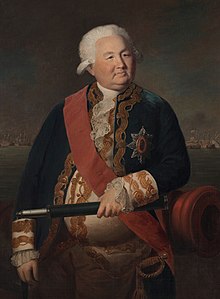
Back Assedio di Negapatam Italian ナーガパッティナム包囲戦 Japanese Oblężenie Negapatamu Polish நாகப்பட்டினம் முற்றுகை Tamil Облога Негапатама (1781) Ukrainian
| Siege of Negapatam | |||||||
|---|---|---|---|---|---|---|---|
| Part of the Fourth Anglo-Dutch War and the Second Anglo-Mysore War | |||||||
 A portrait of Edward Hughes | |||||||
| |||||||
| Belligerents | |||||||
|
|
| ||||||
| Commanders and leaders | |||||||
|
Hector Munro Edward Hughes |
| ||||||
| Strength | |||||||
| 4,000 troops |
6,100 Dutch colonial troops
| ||||||
| Casualties and losses | |||||||
| Light |
Unknown killed/wounded thousands captured | ||||||
The siege of Negapatam was the first major offensive military action on the Indian subcontinent following the arrival of news that war had been declared between Great Britain and the Dutch Republic, beginning the Fourth Anglo-Dutch War. A British force besieged the Dutch-controlled port of Negapatam, the capital of Dutch Coromandel, on the eastern coast of India, which capitulated after the fortification's walls were breached. The Dutch garrison consisted of 500 European troops, 5,500 local troops, and 2,000 troops of Hyder Ali, the ruler of Mysore.
While many British troops were occupied with fighting Hyder Ali's armies as part of the Second Anglo-Mysore War, and General Eyre Coote was opposed to offensive actions against the Dutch, Lord Macartney, the governor of Madras, was able to raise more than 4,000 troops and secure the assistance of Admiral Sir Edward Hughes to defeat the larger Dutch and Mysorean defence force.